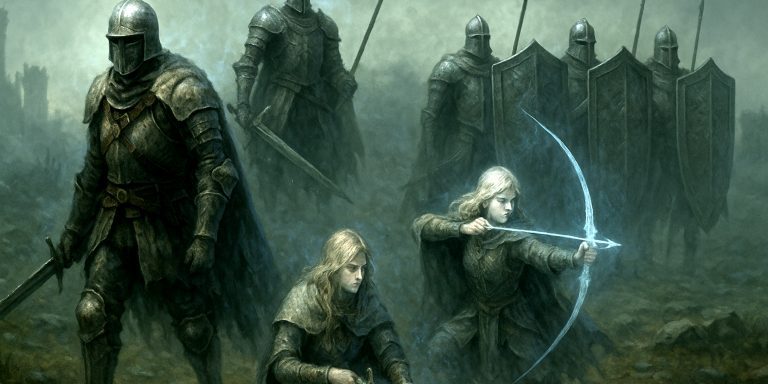
Clerics in Baldur’s Gate 3 offer a rare blend of divine magic, martial skill, and unmatched versatility. They can support a party, control the battlefield, and dish out serious damage depending on how you build them. This guide breaks down everything you need to know to create the most effective Cleric, from domains and races to feats, spell prep, and combat tactics.
Choosing Your Domain
Your subclass, known as a Divine Domain, shapes your entire playstyle. Each offers a unique spell list, bonus proficiencies, and tactical flavour. Below are the standout options for an ultimate Cleric build.
War Domain (Best for Battle-Focused Builds)
- Extra Attack at level 6.
- Bonus action attacks via War Priest.
- Gains martial weapon proficiency and heavy armour.
Light Domain (Best for Offensive Spellcasting)
- Radiance of the Dawn clears out darkness and crowds.
- Powerful fire and light-based spells like Flaming Sphere and Wall of Fire.
Life Domain (Best Healer Option)
- Boosts healing with Disciple of Life.
- Extra healing from Cure Wounds and Healing Word becomes significant.
Tempest Domain (Best for Burst Damage)
- Maximise lightning and thunder damage with Channel Divinity.
- Access to Call Lightning and Destructive Wave for devastating AoE.
Trickery Domain (Utility & Stealth)
- Pass Without Trace and Blessing of the Trickster offer party-wide stealth.
- Better suited for support and infiltration-focused runs.
For an all-round, powerful Cleric, War and Tempest tend to offer the most direct combat impact.
Race and Background
Race choices that boost Wisdom or offer unique utility are ideal.
Recommended Races:
- Wood Elf: +1 Wisdom, increased movement, and Stealth proficiency.
- Half-Elf (High or Wood): Flexible stats and Fey Ancestry for charm resistance.
- Gold Dwarf: +1 Wisdom, extra HP, and physical resilience.
- Human: All-around stat increase for balanced growth.
Background Options:
- Acolyte: Two Religion-based skills and strong roleplay synergy.
- Sage: Arcana and History for knowledge-driven play.
- Folk Hero: Animal Handling and Survival, decent for exploration.
Ability Score Allocation
Clerics depend on Wisdom for their spellcasting and saving throw DCs. Constitution is important for concentration and durability, while Strength or Dexterity will depend on your domain.
Point Buy Suggestion:
| Stat | Value | Notes |
|---|---|---|
| Strength | 14 | For War/Tempest melee builds |
| Dexterity | 10-12 | Adjust based on armour type |
| Constitution | 14 | Keeps you alive and casting |
| Intelligence | 8 | Dump stat |
| Wisdom | 16 | Core spellcasting stat |
| Charisma | 10 | Optional, slight dialogue edge |
Key Spells by Tier
Clerics have access to all spells on their list and can prepare a limited number each day based on Wisdom mod + Cleric level. Here are standout choices at each tier:
Level 1
- Healing Word (bonus action heal)
- Bless (combat buff)
- Guiding Bolt (strong ranged opener)
- Shield of Faith (AC boost for tanks)
Level 2
- Spiritual Weapon (bonus action force damage)
- Hold Person (crowd control)
- Lesser Restoration (utility cure)
Level 3
- Spirit Guardians (signature AoE for melee Clerics)
- Revivify (early resurrection)
- Dispel Magic (removes enemy buffs)
Level 4–5
- Guardian of Faith, Death Ward, Flame Strike, Greater Restoration
Must-Have Cantrips:
- Sacred Flame (ranged radiant damage)
- Thaumaturgy (RP and intimidation)
- Guidance (boosts checks constantly)
Feats and Progression
Clerics benefit from feats that enhance survivability, spell output, or concentration.
Feats to Consider:
- War Caster: Concentration advantage and better spell opportunity attacks.
- Resilient (Con): Boosts CON saves to maintain spells like Bless and Spirit Guardians.
- Tough: Extra HP to keep you upright on the front lines.
- Shield Master: For Strength builds, adds defence and shove utility.
You can also boost Wisdom at level 4 or 8 for spell DC improvements.
Equipment and Armour
Clerics can be heavily armoured or nimble casters, depending on your subclass.
Armour:
- War and Life Domain: Heavy armour (e.g. Chain Mail or Plate).
- Others: Medium armour like Half Plate or Scale Mail.
Weapons:
- Warhammer, Mace, or Morningstar for Strength builds.
- Quarterstaff or Light Crossbow for utility casters.
Shields:
- Always equip one unless you dual-wield or use a two-hander (e.g. War Domain with Polearm).
Holy Symbol:
- Essential for spellcasting. Use a shield or amulet version depending on your kit.
Combat Strategy
Clerics shine when they maintain battlefield control while keeping allies alive.
Melee Focus (War, Tempest, Life):
- Open with Bless or Shield of Faith.
- Use Spiritual Weapon early.
- Keep Spirit Guardians active and stay in the thick of it.
Ranged Focus (Light, Trickery):
- Use Guiding Bolt to open.
- Follow up with Hold Person or Blindness.
- Position carefully to avoid concentration disruption.
Support Focus (Life, Knowledge):
- Prioritise heals and buffs.
- Keep an eye on enemy spellcasters to use Silence or Dispel Magic.
- Use Channel Divinity wisely depending on your domain effect.
Party Synergy
Clerics work well with high-damage and control-heavy allies. Pair with:
- Fighters or Paladins who draw aggro while you heal or control.
- Rogues who benefit from Guiding Bolt’s advantage setup.
- Sorcerers or Wizards for AoE synergy and long-range support.
The Seven Swords Takeaway
Clerics can be the spine of any party. With the right domain and spell choices, you can adapt to nearly any situation without losing effectiveness. Whether you’re holding the line with Spirit Guardians, keeping the team alive, or calling down divine fire, a properly built Cleric never feels like a passive support role. Build with intent and you’ll have one of the strongest classes in the game.



